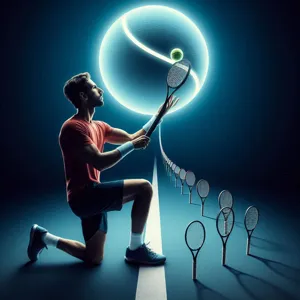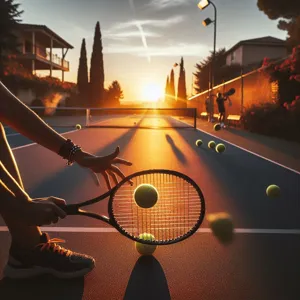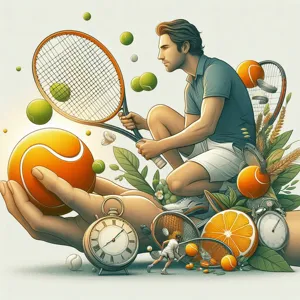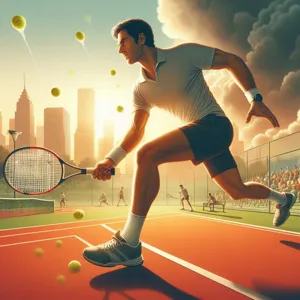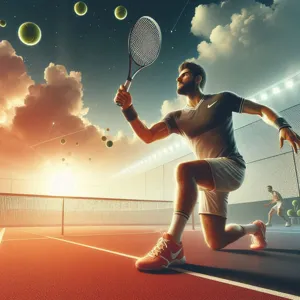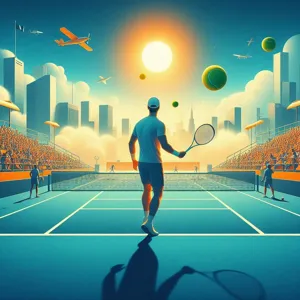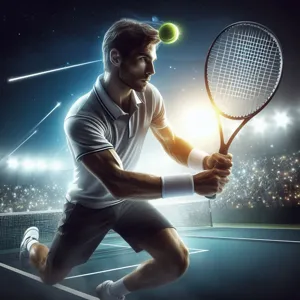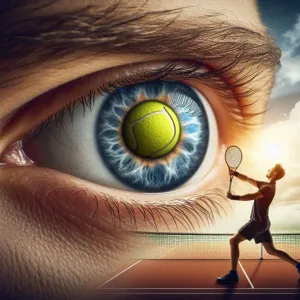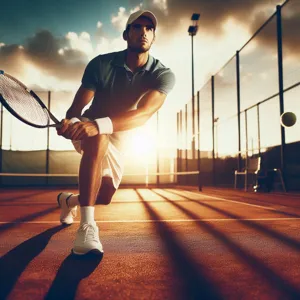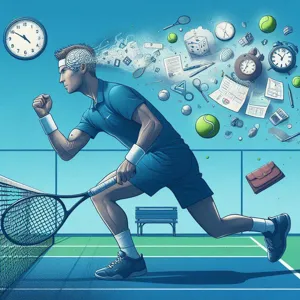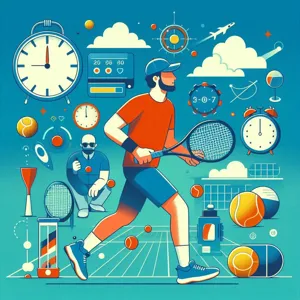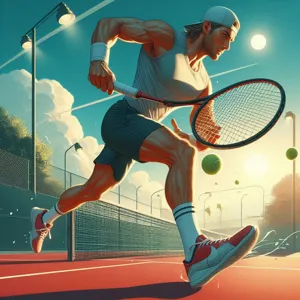Whether you’re a seasoned pro or a weekend warrior, the key to tennis success lies not just in your technique, but also in your stamina.
As matches stretch on and the competition heats up, maintaining your energy levels can make all the difference between victory and defeat. Imagine gliding effortlessly across the court, your feet light and quick, as you return each serve with precision and power. In this blog post, we’ll delve into five essential tips designed to enhance your stamina, enabling you to outlast your opponents and elevate your game to new heights. From tailored training regimens to nutrition strategies and mental conditioning, these insights will empower you to push past your limits and play your best, even in those crucial final sets. Get ready to ace your game and transform your approach to tennis with these powerful stamina-boosting techniques!
1. Understanding Stamina and Its Importance in Tennis

When it comes to excelling on the tennis court, stamina is not just a nice-to-have; it’s a game-changer. Stamina, in the context of tennis, refers to the ability to sustain prolonged physical and mental effort. It encompasses both aerobic endurance, which allows players to keep moving energetically throughout long rallies and matches, and anaerobic endurance, essential for those explosive bursts of speed to chase down shots.
Understanding stamina is crucial because tennis is a sport that often tests the limits of a player’s endurance. Matches can stretch beyond the typical two-hour mark, especially in tournament settings where players are pushed to their limits. A player’s level of stamina can determine their performance when the game gets tough; the difference between winning a crucial point or losing it can hinge on whether you have the energy to make that final sprint.
Moreover, stamina impacts other facets of your game, including recovery time between points and overall mental resilience. A player with high stamina not only physically withstands the rigors of the sport but also maintains focus and strategic thinking as fatigue sets in. This mental fortitude allows for better decision-making during critical moments, ensuring that players can execute their game plans effectively even under pressure.
Incorporating stamina training into your routine means you’re not just preparing your body, but you’re also sharpening your competitive edge. Whether you’re a weekend warrior or an aspiring pro, understanding the role of stamina in tennis is the first step toward achieving your best performance on the court.
2. Tip 1: Incorporate Interval Training into Your Routine
When it comes to boosting your stamina for tennis, incorporating interval training into your routine is a game changer. This method involves alternating between high-intensity bursts of activity and periods of lower intensity or rest. Not only does it enhance cardiovascular endurance, but it also mimics the stop-and-start nature of a tennis match, making it an ideal training approach for players looking to elevate their performance on the court.
For instance, you might start with a dynamic warm-up to get your blood flowing, followed by a series of sprints or agility drills that last for 30 seconds, followed by 30 seconds of walking or light jogging to recover. This cycle can be repeated several times, gradually increasing the intensity and duration as your fitness improves.
Additionally, consider incorporating tennis-specific drills during your intervals. Alternate between short, fast-paced rallies and slower, strategic play to build endurance while also honing your skills. Not only will this help you withstand the physical demands of a match, but it will also sharpen your reaction time and improve your overall agility.
Interval training not only builds stamina but also enhances mental resilience. As you push through those tough intervals, you’ll learn to embrace discomfort, a crucial aspect of competing at higher levels. By regularly integrating this training into your regimen, you’ll find yourself better prepared to outlast your opponents, maintain focus, and elevate your game when it matters most. So lace up your sneakers and hit the court, as this powerful training technique is your ticket to sustaining energy and achieving success in every match.
3. Tip 2: Focus on Aerobic Conditioning

When it comes to tennis, the ability to sustain energy levels throughout lengthy matches is paramount. That’s where aerobic conditioning comes into play. This fundamental aspect of fitness serves as the foundation for your stamina, enabling you to maintain a high level of performance, even as the match drags on and fatigue sets in.
Aerobic conditioning is all about training your heart and lungs to efficiently deliver oxygen to your muscles. It involves engaging in activities that elevate your heart rate for extended periods, which can significantly enhance your endurance on the court. Think of your favorite tennis drills, but extended into a more sustained effort. Incorporate steady-state cardio workouts, such as jogging, cycling, or swimming, into your weekly routine to build a strong aerobic base.
Interval training can also be a game-changer. By alternating between high-intensity bursts—like sprinting or explosive footwork drills—and periods of active recovery, you can mimic the stop-and-start nature of a tennis match. This not only helps improve your cardiovascular fitness but also conditions your body to recover more quickly between points, allowing you to stay sharp during critical moments.
Moreover, consider incorporating sport-specific drills that enhance your aerobic capacity. For instance, practice rallying with a partner at a steady pace for longer durations, or engage in longer match simulations where you play multiple sets with minimal breaks. This will not only boost your aerobic conditioning but also sharpen your tactical skills and mental resilience.
By focusing on aerobic conditioning, you’re setting the stage for prolonged success on the court. With enhanced stamina, you’ll find yourself chasing down every ball with ease and maintaining your energy levels, even in the most demanding matches. So lace up those shoes and hit the court—your game will thank you for it!
4. Tip 3: Strength Training for Endurance
When it comes to boosting your stamina for tennis, integrating strength training into your routine can be a game-changer. While many players focus solely on cardio to enhance their endurance, neglecting strength training can leave you lacking the physical resilience needed for those long, grueling matches. A well-structured strength training program not only builds muscle but also improves your overall stability, balance, and power, all of which are crucial on the court.
Incorporate exercises that target the major muscle groups used in tennis. Squats, lunges, and deadlifts are excellent for building leg strength, which is vital for quick directional changes and explosive movements. Additionally, exercises like push-ups and pull-ups help to enhance upper body strength, allowing you to generate more power in your serves and groundstrokes.
Don’t forget about your core! A strong core is the foundation of your athletic performance, as it helps with stability and rotational power. Incorporate planks, Russian twists, and medicine ball throws into your regimen to develop a robust core that can withstand the demands of a match.
Aim for at least two to three strength training sessions per week, focusing on both compound and isolated movements. As you progress, gradually increase the weights and resistance to continue challenging your muscles. This not only helps in building endurance but also reduces the risk of injury by strengthening the muscles and connective tissues that support your joints.
By combining strength training with your on-court practice and cardio workouts, you’ll not only boost your stamina but also enhance your overall performance. You’ll find yourself moving faster, hitting harder, and recovering quicker—all essential components of a successful tennis game. So, lace up those sneakers and hit the gym; your future self on the court will thank you!
5. Tip 4: Nutrition Strategies for Sustained Energy

When it comes to boosting stamina for tennis success, your nutrition plays a crucial role in ensuring you have the sustained energy needed to perform at your best. Unlike other sports, tennis demands not only explosive power but also endurance, as matches can stretch on for hours. To keep your energy levels high throughout your game, it’s essential to focus on a well-rounded diet that fuels your body efficiently.
Firstly, prioritize complex carbohydrates, which are your primary source of energy. Foods like whole grains, brown rice, and sweet potatoes should be staples in your diet, as they provide a slow and steady release of glucose into your bloodstream, helping to maintain your energy levels during long training sessions and matches. Pair these carbohydrates with lean proteins—think chicken, fish, or legumes—to support muscle repair and recovery.
Hydration is another key factor. Dehydration can lead to fatigue and decreased performance, so make sure to drink plenty of water throughout the day, especially before and after your practice sessions. Consider adding electrolyte-rich drinks during intense workouts or matches to replenish the minerals lost through sweat.
Moreover, timing your meals can significantly impact your stamina. Aim to eat a well-balanced meal 2-3 hours before you play, incorporating a mix of carbs, proteins, and healthy fats. For a quick energy boost, snacks like bananas or energy bars can be great just before you step onto the court. After the game, refuel with a recovery meal that includes protein and carbs within 30 minutes to help your body repair and prepare for the next challenge.
Lastly, don’t overlook the power of healthy snacking. Keep nutritious options like nuts, yogurt, and fruits on hand to keep your energy levels consistent throughout the day. By strategically planning your nutrition, you’ll not only enhance your stamina but also improve your overall performance on the court, paving the way for tennis success.
6. Tip 5: The Role of Hydration in Performance
Hydration plays a pivotal role in enhancing your performance on the tennis court, yet it is often overlooked by players focused on their training routines. Proper hydration is not just about quenching your thirst; it’s about ensuring your body operates at peak efficiency. Dehydration can lead to fatigue, decreased concentration, and muscle cramps, all of which can spell disaster during a crucial match.
As you sweat through intense rallies and serve after serve, your body loses essential fluids and electrolytes. Replenishing these losses is vital to maintaining your stamina and preventing the dreaded performance drop-off. Aim to drink water before, during, and after your matches. A general guideline is to start hydrating well in advance of your game—ideally, you should be sipping water throughout the day leading up to your match.
During play, consider incorporating electrolyte drinks, especially for longer matches or in hotter weather. These drinks can help restore vital minerals like sodium, potassium, and magnesium, which are lost through sweat, and can help fend off fatigue.
After your game, don’t neglect hydration; this is the time when your muscles are recovering and need to rebuild. Drinking water or a recovery drink can help facilitate this process.
In short, staying hydrated is an essential, yet simple strategy that can significantly impact your endurance and overall performance in tennis. By making hydration a priority, you’ll ensure that you stay sharp, focused, and ready to ace your game, match after match.
7. Developing a Personalized Training Plan

Creating a personalized training plan is crucial for any athlete looking to improve their stamina and overall performance on the tennis court. Unlike a one-size-fits-all approach, a tailored training regimen takes into account your unique fitness level, playing style, and specific goals. This customization allows you to focus on the areas that will yield the most significant improvements, ensuring that every minute spent training is effective and purposeful.
Start by assessing your current physical condition. Are you a beginner struggling with endurance, or are you a seasoned player looking to maintain peak performance? Once you have a clear understanding of your baseline, set specific, measurable goals. Whether it’s increasing your match duration, improving your recovery time, or enhancing your overall agility, having clear objectives will guide your training efforts.
Incorporate a mix of cardiovascular workouts, strength training, and flexibility exercises into your plan. Tennis requires not only endurance but also explosive power and agility. Consider including interval training to mimic the stop-and-start nature of the game, as well as drills that enhance your footwork and quickness on the court. Don’t forget to integrate rest and recovery days to allow your body to heal and adapt, as overtraining can lead to burnout or injury.
Regularly evaluate your progress. Keep a training journal to track your workouts, stamina levels, and performance in matches. This will help you identify what’s working and what needs adjustment. Remember, a personalized training plan is a living document—don’t hesitate to modify it as you improve or as your goals evolve.
By investing the time to develop a personalized training plan, you’ll not only boost your stamina but also enhance your overall game, giving you the competitive edge needed for success in tennis. Embrace the journey, stay committed, and watch as your hard work pays off on the court.
8. The Importance of Rest and Recovery
When it comes to enhancing your stamina on the tennis court, the importance of rest and recovery cannot be overstated. Many players often fall into the trap of thinking that more practice and longer training sessions will automatically translate into better performance. However, neglecting rest can lead to diminished returns, fatigue, and even injury.
Rest is not merely a luxury; it’s a crucial component of any effective training regimen. Your body needs time to repair and rebuild after the physical demands of intense practice sessions and matches. During rest periods, your muscles recover, your energy stores are replenished, and your overall performance is optimized for the next challenge. This is when the real gains occur—your body adapts to the stresses you’ve placed on it, becoming stronger and more resilient.
Incorporating active recovery days into your routine can also be beneficial. These days might include light activities such as yoga, swimming, or brisk walking, which help maintain blood flow to your muscles without adding undue strain. Stretching and foam rolling are other excellent ways to promote recovery, aiding in muscle flexibility and reducing soreness.
Furthermore, adequate sleep is vital for recovery. During deep sleep, your body releases growth hormones that are essential for muscle repair and growth. Aim for 7-9 hours of quality sleep each night, and consider establishing a consistent sleep schedule to enhance your recovery process.
Ultimately, recognizing the significance of rest and recovery will set you apart from the competition. By giving your body the time it needs to heal and rebuild, you’ll find that your stamina will improve, allowing you to play longer and with greater intensity on the court. Remember, in the pursuit of tennis success, rest is not the enemy—it’s your ally.
9. Mental Stamina: Techniques to Stay Focused
Mental stamina plays a pivotal role in tennis, often distinguishing the good players from the great ones. While physical endurance is crucial for enduring long matches, the ability to maintain focus and composure under pressure is what truly sets champions apart. To enhance your mental stamina, you can employ a variety of techniques that ensure you stay sharp and resilient throughout your game.
First and foremost, visualization is a powerful tool. Before stepping onto the court, take a moment to close your eyes and imagine yourself executing your shots perfectly. Picture the ball sailing over the net, your feet moving fluidly, and your body responding effortlessly. This mental rehearsal not only boosts your confidence but also ingrains muscle memory, allowing you to perform better when it counts.
Another technique to consider is mindfulness meditation. By practicing mindfulness, you can train your mind to stay present in the moment, reducing anxiety and distractions that can derail your focus during a match. Techniques such as deep breathing and body scanning can help you ground yourself and regain control, especially during crucial points in a game when nerves may start to creep in.
Additionally, setting specific, achievable goals can enhance your mental stamina. Instead of fixating on winning the match, focus on smaller, measurable objectives—such as improving your serve percentage or maintaining your footwork throughout the set. This shifts your focus from external pressures to personal growth, making the challenge feel more manageable.
Lastly, develop a pre-match routine that primes your mind for success. Whether it’s listening to your favorite motivational playlist, engaging in light stretching, or practicing affirmations—find activities that help you enter a focused and positive state of mind. A consistent routine signals to your brain that it’s time to compete, reducing anxiety and enhancing your mental readiness.
By incorporating these techniques into your training regimen, you’ll cultivate the mental stamina necessary for sustained focus and performance under pressure, ultimately giving you the edge you need to excel on the tennis court.
10. Monitoring Your Progress and Adjusting Your Approach
Monitoring your progress and adjusting your approach is a crucial aspect of boosting your stamina for tennis success. Just like a well-tuned racket, your training regimen requires regular adjustments to ensure peak performance. Start by keeping a detailed training diary where you document not only your practice sessions and match performances but also your physical and mental states during these activities. Tracking metrics such as duration of play, heart rate, and recovery times can provide invaluable insights into your endurance levels.
As you analyze your progress, look for patterns that may indicate areas for improvement. Are you consistently fatigued during the later stages of a match? This could signal the need for longer or more intense conditioning sessions. Conversely, if you find yourself struggling to recover after workouts, it may be time to incorporate rest days or lighter training sessions into your routine.
Additionally, consider using fitness apps or wearables that provide real-time data, tracking your heart rate and caloric burn during play. These tools can help you set specific targets and keep your training aligned with your goals.
Remember, it’s essential to remain flexible in your approach. Tennis is not just about physical stamina; it also requires mental resilience. If you notice that certain training methods are causing burnout or diminishing returns, don’t hesitate to switch things up. Experiment with different drills, cross-training activities, or even mindfulness practices to find what best enhances your overall stamina and performance on the court.
By continuously monitoring your progress and being willing to adapt, you not only prepare your body for the rigors of tennis but also foster a mindset geared toward growth and success. This iterative process will empower you to reach new heights in your game, ensuring that you remain competitive and energized when it matters most.
11. Common Mistakes to Avoid When Building Stamina
When it comes to boosting stamina for tennis, avoiding common pitfalls can make all the difference in your training effectiveness. One of the most frequent mistakes players make is underestimating the importance of rest and recovery. Many athletes push themselves relentlessly, believing that more is always better. However, overtraining can lead to fatigue and injuries, ultimately hindering your performance on the court. It’s crucial to incorporate rest days into your routine, allowing your body to repair and rebuild.
Another common error is neglecting the role of nutrition. Fueling your body with the right foods before and after training sessions is essential for enhancing stamina. Skipping meals or relying too heavily on processed foods can leave you feeling drained and unable to sustain your energy levels during play. Focus on a balanced diet rich in carbohydrates, proteins, and healthy fats, and stay hydrated to keep your energy reserves topped up.
Additionally, many players fail to mix up their training regimen. Sticking to the same routine day in and day out can lead to physical and mental fatigue. Incorporating a variety of cardiovascular exercises, strength training, and flexibility workouts not only keeps things fresh but also helps to enhance different aspects of your stamina. Consider adding interval training, circuit workouts, or even yoga to your weekly schedule for a well-rounded approach.
Lastly, it’s essential to set realistic goals. Some players may become discouraged when they don’t see immediate improvements in their stamina. Progress takes time, and it’s vital to celebrate small victories along the way. Setting achievable milestones can keep you motivated and focused, making your stamina-building journey much more enjoyable.
By steering clear of these common mistakes, you’ll be well on your way to building the stamina needed for tennis success, allowing you to play longer, stronger, and with greater resilience on the court.
12. How to Stay Motivated During Your Training
Staying motivated during your training is crucial for boosting your stamina and achieving success on the tennis court. The journey to peak performance can often feel daunting, but finding and maintaining motivation is key to pushing through the tough days. Here are some effective strategies to help keep your spirits high and your focus sharp.
**Set Specific Goals**: Start by establishing clear, achievable goals. Whether it’s improving your serve speed, increasing your match endurance, or mastering a new technique, having a target gives your training purpose. Break these larger goals into smaller, manageable milestones and celebrate each achievement. This sense of progression will provide a continuous source of motivation.
**Create a Training Routine**: Consistency is vital in any training regimen. Develop a structured routine that fits your lifestyle and stick to it. By setting aside specific times for training, you create a sense of commitment that makes it easier to stay on track. Plus, a well-planned routine helps to build the discipline necessary for improvement.
**Mix It Up**: Repetition can lead to boredom, so keep your training sessions fresh and exciting. Incorporate a variety of drills, exercises, and even cross-training activities. Not only does this prevent monotony, but it also helps develop different muscle groups and skill sets, ultimately enhancing your overall game.
**Find a Training Partner**: Having a training partner can significantly boost your motivation. Whether it’s a friend, coach, or fellow player, training with someone else provides accountability and makes practices more enjoyable. You can challenge each other, share tips, and celebrate successes together, creating a supportive environment that fosters growth.
**Visualize Your Success**: Visualization is a powerful tool in sports psychology. Take time to mentally rehearse your matches and training sessions, picturing yourself executing techniques flawlessly and performing at your best. This positive imagery not only enhances your confidence but also reinforces your commitment to your training goals.
By integrating these strategies into your training regimen, you’ll find it easier to stay motivated and push through the challenging moments. Remember, the path to tennis success is a marathon, not a sprint. Staying focused and motivated will not only enhance your stamina but will also pave the way for long-term achievement on the court.
13. Real-Life Success Stories: Athletes Who Boosted Their Stamina
When it comes to enhancing stamina in tennis, real-life success stories of athletes can serve as profound inspiration and practical guidance. Take the legendary Rafael Nadal, for instance. Known for his tenacity on the court, Nadal’s stamina is a result of a meticulously crafted training regimen that includes not just on-court drills but also extensive cross-training and conditioning workouts. His commitment to building endurance has allowed him to outlast opponents in grueling five-set matches, making him one of the most formidable players in the sport.
Similarly, Serena Williams exemplifies the importance of stamina in achieving peak performance. Her rigorous training routines emphasize interval training and strength conditioning, which are key to sustaining her powerful play throughout matches. Williams often shares insights into her off-court workouts, highlighting how they help her maintain the energy levels needed for long matches while also reducing the risk of injury.
Then there’s Novak Djokovic, whose emphasis on a holistic approach to stamina includes not only physical training but also mental resilience. Djokovic incorporates yoga and meditation into his regimen, allowing him to stay focused and calm during intense rallies. This multifaceted strategy enhances his stamina, ensuring he remains at the top of his game, even under immense pressure.
These athletes not only showcase the dedication required to boost stamina but also highlight the diverse strategies that can be employed. From tailored training programs to a focus on mental well-being, their journeys underscore that with the right mindset and approach, every aspiring tennis player can elevate their stamina and, ultimately, their game. Embrace their stories as motivation to develop your own stamina-boosting strategy, and who knows? You could be the next success story on your path to tennis excellence.
14. Conclusion: Putting It All Together for Tennis Success
In conclusion, boosting your stamina for tennis success is not merely about hitting the courts and playing for hours on end; it’s a multifaceted approach that integrates physical training, mental conditioning, and dietary strategies. By following the essential tips outlined in this guide, you can create a comprehensive plan that will not only enhance your endurance but also sharpen your overall performance on the court.
Start by incorporating dynamic workouts and interval training sessions into your routine to build explosive speed and lasting endurance. Remember that consistency is key; regular practice will allow your body to adapt and thrive under the physical demands of the game. Complementing these workouts with sport-specific drills will ensure that your stamina translates directly into improved match performance.
Equally important is the mental aspect of stamina. Visualization techniques and mindfulness exercises can help you remain focused and calm during high-pressure situations. Tennis is as much a mental game as it is a physical one, so nurturing your psychological resilience can make all the difference when you find yourself in a grueling match.
Don’t overlook the crucial role of nutrition and hydration in your stamina-building journey. Fueling your body with the right nutrients and maintaining proper hydration levels will provide the energy necessary for peak performance. A balanced diet rich in carbohydrates, proteins, and healthy fats will not only support your training but also aid in recovery.
As you put these strategies into practice, remember to listen to your body and adjust as needed. Stamina is built over time, and it’s essential to find a balance that works for you. Embrace the journey, celebrate your progress, and keep pushing your limits. With dedication and the right approach, you’ll find yourself not only lasting longer on the court but also enjoying the game more than ever. So lace up your shoes, grab your racket, and get ready to ace your game!
15. Additional Resources for Further Improvement
As you embark on your journey to boost your stamina for tennis, a wealth of additional resources awaits to enhance your training and performance. Whether you’re a budding athlete or a seasoned player seeking that extra edge, tapping into these resources can make a significant difference in your game.
**Books and Guides**: There are numerous books dedicated to tennis training and athletic conditioning that provide valuable insights. Titles like “The Tennis Fitness Book” by the United States Tennis Association offer comprehensive fitness routines tailored specifically for tennis players, emphasizing agility, strength, and endurance.
**Online Courses and Webinars**: Consider enrolling in online courses that focus on sports conditioning and stamina building. Websites like Udemy and Coursera feature classes taught by experienced coaches and athletes who share techniques and strategies to enhance your physical capabilities on the court.
**YouTube Channels**: visual learners will find YouTube to be an invaluable resource. Channels dedicated to tennis training often showcase drills, workout routines, and expert tips from professional players and coaches. Following channels like Essential Tennis or Tennis Evolution can provide you with practical exercises that you can incorporate into your regimen.
**Fitness Apps**: Leverage technology with fitness apps that track your workouts and monitor your progress. Apps like Strava or MyFitnessPal allow you to set goals, log your activities, and even connect with fellow tennis enthusiasts for motivation and accountability.
**community Support**: Joining local tennis clubs or online forums can provide you with a supportive community of like-minded individuals. Engaging with other players allows you to share experiences, ask for advice, and even discover new training partners who can push you to stay committed to your stamina-building journey.
By utilizing these additional resources, you can enrich your training experience and ensure that you’re not only working hard but also working smart. As you integrate these tools into your routine, you’ll find yourself more prepared, more energized, and ultimately more successful on the court. Embrace the resources at your disposal, and watch as your stamina soars to new heights!
In conclusion, boosting your stamina for tennis is not just about physical endurance; it’s about creating a holistic approach that includes proper training, nutrition, and mental resilience. By incorporating these five essential tips into your routine, you’re setting yourself up for success on the court. Remember, every champion was once a contender who refused to give up. So, lace up your shoes, hit the practice courts, and embrace the journey towards becoming a more formidable player. With dedication and these strategies in your arsenal, you’ll not only ace your game but also enjoy every moment of your tennis experience. Here’s to smashing your goals and playing your best match yet!



